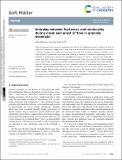Interplay between hysteresis and nonlocality during onset and arrest of flow in granular materials
Author(s)
Mowlavi, Saviz; Kamrin, Kenneth N
Downloadd1sm00659b.pdf (5.399Mb)
Publisher with Creative Commons License
Publisher with Creative Commons License
Creative Commons Attribution
Terms of use
Metadata
Show full item recordAbstract
The jamming transition in granular materials is well-known for exhibiting hysteresis, wherein the level of shear stress required to trigger flow is larger than that below which flow stops. Although such behavior is typically modeled as a simple non-monotonic flow rule, the rheology of granular materials is also nonlocal due to cooperativity at the grain scale, leading for instance to increased strengthening of the flow threshold as system size is reduced. We investigate how these two effects – hysteresis and nonlocality – couple with each other by incorporating non-monotonicity of the flow rule into the nonlocal granular fluidity (NGF) model, a nonlocal constitutive model for granular flows. By artificially tuning the strength of nonlocal diffusion, we demonstrate that both ingredients are key to explaining certain features of the hysteretic transition between flow and arrest. Finally, we assess the ability of the NGF model to quantitatively predict material behavior both around the transition and in the flowing regime, through stress-driven discrete element method (DEM) simulations of flow onset and arrest in various geometries. Along the way, we develop a new methodology to compare deterministic model predictions with the stochastic behavior exhibited by the DEM simulations around the jamming transition.
Date issued
2021-07Department
Massachusetts Institute of Technology. Department of Mechanical EngineeringJournal
Soft Matter
Publisher
Royal Society of Chemistry (RSC)
Citation
Mowlavi, Saviz and Ken Kamrin. "Interplay between hysteresis and nonlocality during onset and arrest of flow in granular materials." Soft Matter 17 (July 2021): 7359-7375. © 2021 The Royal Society of Chemistry
Version: Final published version
ISSN
1744-683X
1744-6848